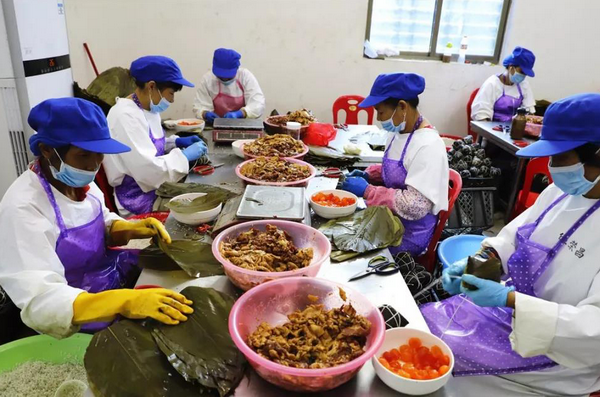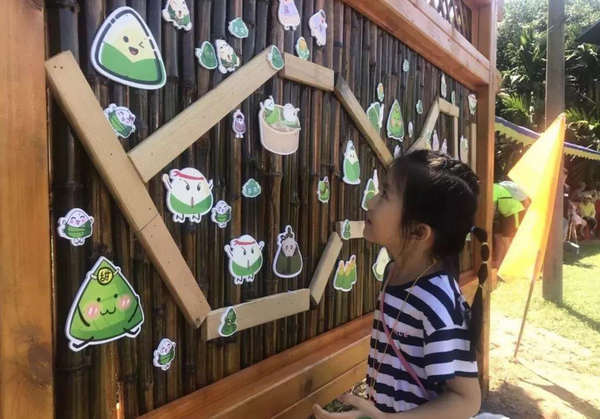Ding’an shaking off poverty through zongzi industry
chinagate.cn,March 11, 2019 Adjust font size:
Zongzi, also known as sticky rice dumplings, are a traditional Chinese dish made of glutinous rice stuffed with different fillings and wrapped in leaves. In most parts of China zongzi are only consumed around Dragon Boat Festival, which commemorates the death of Qu Yuan, a Chinese poet and minister of the State of Chu during the Warring States period between 475 and 221 B.C. But such food is common for breakfast in the island province of Hainan that lies in southern China.
The most popular fillings in Hainan Zongzi are pork and salty duck egg yolk. Black Pork Zongzi is one of the best-known varieties in the region.
The Black Pork Zongzi is a specialty of Ding’an County, which is located in the northeastern part of Hainan. These Ding’an Zongzi are filled with pork from Hainan’s renowned organic black pigs, which are fed with natural food, giving them a chewier texture and a stronger flavor. The wrapping method of this type of zongzi is also unique, making Ding’an Zongzi delicious and aesthetically pleasing.

As the Dragon Boat Festival approaches, workers at the Ding’an zongzi plant in Ganyong Village of Ding’an prepare for their busiest time of year.
“Though zongzi look small, it takes a lot of effort to make them,” said Chen Haixia, an impoverished villager from Ganyong, who was busy on the production line.
The zongzi plant is near Chen’s home, Chen said this makes it easy for her to take care of her family after work. She could make at least 500 zongzi every day and earn more than 300 yuan (U.S. $45).
In recent years, Ding’an officials began to develop the zongzi industry to lift local residents out of poverty.
“Zongzi is the traditional taste of Ding’an Town. Almost everyone born here is enthusiastic about developing the zongzi industry,” said Fu Yongding, vice director of the village committee.
According to Fu, a zongzi production Company opened a plant in his village in 2016. This opened a steady market for the sales of local pork and created more job opportunities for villagers as well. In the past three years, more than 100 impoverished villagers in Ganyong and surrounding villages found work within this company.
Chen's family used to take odd jobs and could barely earn enough to support their three children, but since she and her husband started working at a zongzi plant in 2016, they have earned a steady income of at least 2,000 yuan (U.S. $290) a month each in the off season, and much more in the peak season.
During the run up to the festival, the plant where Chen works produces 40,000-50,000 zongzi a day, 10 times the usual number.
Many villages in Ding An have now introduced zongzi plants, providing job opportunities for impoverished households. According to the local government, Ding'an sold 18 million zongzi in 2017, worth 270 million yuan (U.S. $39.4 million). This drove the sales of more than 1800 tons of pork and rice, 12 million salted duck eggs, and more than 90 million leaf wrappers.
Today, Ding’an Zongzi are sold on high-speed trains and planes, as well as on the Internet. They were also served at the annual conferences of Boao Forum for Asia, a non-profit organisation that hosts high-level forums for leaders of nations
The Ding’an government offers training for poor residents who are willing to work in zongzi plants, and encourages the plants to give preference to them. The Ding’an Zongzi Association and several zongzi companies have also set up a poverty alleviation fund that helps impoverished households to obtain essentials for daily life and work.
The Ding’an government is also combining zongzi production with tourism to explore new income sources for locals. Hundreds of tourists come to Ganyong’s zongzi plant each day to experience the process of making zongzi and taste special dishes such as Hainan rice and vegetable roll and Ding’an duck rice.
Workers like Chen said that they would never have expected that making zongzi and other country dishes could attract tourists.

There are series of Cartoon images of Ding’an Zongzi painted on the outer wall of the Ganyong zongzi plant. “It looks like a scenic spot,” said the workers.
The Ding’an government said it will continue to extend its zongzi industrial chain, combining with different industries, such as tourism, local agricultural products, and e-commerce to help its residents shake off poverty.
Translated by Zhang Tingting